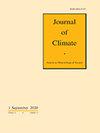Subpolar North Atlantic mean state affects the response of the Atlantic Meridional Overturning Circulation to the North Atlantic Oscillation in CMIP6 models
IF 4
2区 地球科学
Q1 METEOROLOGY & ATMOSPHERIC SCIENCES
引用次数: 0
Abstract
Abstract The Atlantic Meridional Overturning Circulation (AMOC) plays an important role in climate, transporting heat and salt to the subpolar North Atlantic. The AMOC’s variability is sensitive to atmospheric forcing, especially the North Atlantic Oscillation (NAO). Because AMOC observations are short, climate models are a valuable tool to study the AMOC’s variability. Yet, there are known issues with climate models, like uncertainties and systematic biases. To investigate this, pre-industrial control experiments from models participating in the Coupled Model Intercomparison Project phase 6 (CMIP6) are evaluated. There is large, but correlated, spread in the models’ subpolar gyre mean surface temperature and salinity. By splitting models into groups of either a warm-salty or cold-fresh subpolar gyre, it is shown that warm-salty models have a lower sea ice cover in the Labrador Sea and, hence, enable a larger heat loss during a positive NAO. Stratification in the Labrador Sea is also weaker in warm-salty models, such that the larger NAO-related heat loss can also affect greater depths. As a result, subsurface density anomalies are much stronger in the warm-salty models than in those that tend to be cold and fresh. As these anomalies propagate southward along the western boundary, they establish a zonal density gradient anomaly that promotes a stronger delayed AMOC response to the NAO in the warm-salty models. These findings demonstrate how model mean state errors are linked across variables and affect variability, emphasizing the need for improvement of the subpolar North Atlantic mean states in models.北大西洋副极地平均状态影响 CMIP6 模型中大西洋经向翻转环流对北大西洋涛动的响应
摘要 大西洋经向翻转环流(AMOC)在气候中发挥着重要作用,向北大西洋副极地输送热量和盐分。AMOC的变化对大气胁迫非常敏感,尤其是北大西洋涛动(NAO)。由于 AMOC 观测时间较短,气候模式是研究 AMOC 变率的重要工具。然而,气候模式也存在一些已知问题,如不确定性和系统性偏差。为了研究这个问题,对参加耦合模式相互比较项目第 6 阶段(CMIP6)的模式进行了工业化前控制实验评估。模型的副极地涡旋平均表面温度和盐度有很大的差异,但相互关联。通过将模式分成暖咸或冷鲜副极地涡旋两组,结果表明,暖咸模式在拉布拉多海的海冰覆盖率较低,因此在正西北大西洋环流期间热量损失较大。在暖咸模型中,拉布拉多海的分层作用也较弱,因此与西北大西洋环流有关的更大热量损失也会影响到更深处。因此,暖咸型模式的次表层密度异常要比冷鲜型模式强得多。当这些异常沿西部边界向南传播时,它们会形成带状密度梯度异常,从而在暖咸模式中促进更强的延迟AMOC对NAO的响应。这些发现说明了模式平均状态误差是如何在不同变量之间相互联系并影响变率的,强调了改进模式中北大西洋副极地平均状态的必要性。
本文章由计算机程序翻译,如有差异,请以英文原文为准。
求助全文
约1分钟内获得全文
求助全文
来源期刊

Journal of Climate
地学-气象与大气科学
CiteScore
9.30
自引率
14.30%
发文量
490
审稿时长
7.5 months
期刊介绍:
The Journal of Climate (JCLI) (ISSN: 0894-8755; eISSN: 1520-0442) publishes research that advances basic understanding of the dynamics and physics of the climate system on large spatial scales, including variability of the atmosphere, oceans, land surface, and cryosphere; past, present, and projected future changes in the climate system; and climate simulation and prediction.
 求助内容:
求助内容: 应助结果提醒方式:
应助结果提醒方式:


